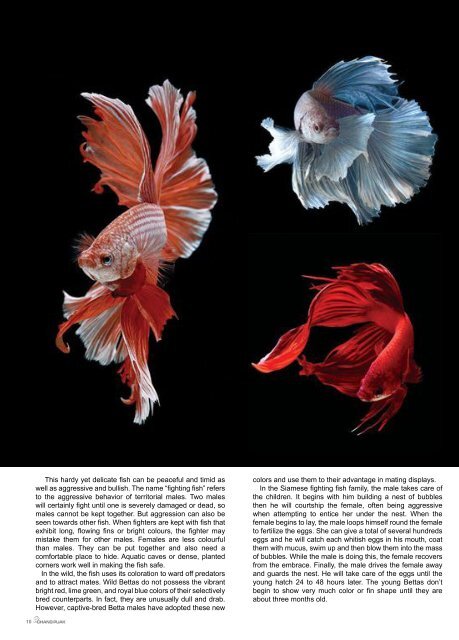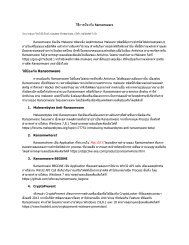Create successful ePaper yourself
Turn your PDF publications into a flip-book with our unique Google optimized e-Paper software.
This hardy yet delicate fish can be peaceful and timid as<br />
well as aggressive and bullish. The name “fighting fish” refers<br />
to the aggressive behavior of territorial males. Two males<br />
will certainly fight until one is severely damaged or dead, so<br />
males cannot be kept together. But aggression can also be<br />
seen towards other fish. When fighters are kept with fish that<br />
exhibit long, flowing fins or bright colours, the fighter may<br />
mistake them for other males. Females are less colourful<br />
than males. They can be put together and also need a<br />
comfortable place to hide. Aquatic caves or dense, planted<br />
corners work well in making the fish safe.<br />
In the wild, the fish uses its coloration to ward off predators<br />
and to attract mates. Wild Bettas do not possess the vibrant<br />
bright red, lime green, and royal blue colors of their selectively<br />
bred counterparts. In fact, they are unusually dull and drab.<br />
However, captive-bred Betta males have adopted these new<br />
colors and use them to their advantage in mating displays.<br />
In the Siamese fighting fish family, the male takes care of<br />
the children. It begins with him building a nest of bubbles<br />
then he will courtship the female, often being aggressive<br />
when attempting to entice her under the nest. When the<br />
female begins to lay, the male loops himself round the female<br />
to fertilize the eggs. She can give a total of several hundreds<br />
eggs and he will catch each whitish eggs in his mouth, coat<br />
them with mucus, swim up and then blow them into the mass<br />
of bubbles. While the male is doing this, the female recovers<br />
from the embrace. Finally, the male drives the female away<br />
and guards the nest. He will take care of the eggs until the<br />
young hatch 24 to 48 hours later. The young Bettas don’t<br />
begin to show very much color or fin shape until they are<br />
about three months old.<br />
当 iPhone6 面 世 全 球 时 , 许 多 用 户 选 择 了 泰 国 斗 鱼 的 图 片 作<br />
为 手 机 壁 纸 。 这 些 高 分 辨 率 屏 保 图 片 背 后 的 作 者 就 是 泰 国 摄 影<br />
师 Visarute Angkatavanich。 这 位 45 岁 的 摄 影 师 , 其 代 表 作 令<br />
人 惊 叹 且 真 正 反 映 了 泰 国 斗 鱼 的 优 雅 和 美 丽 。<br />
泰 国 斗 鱼 , 学 名 为 泰 国 搏 鱼 ( Betta Splendens), 身 形 小 ( 最<br />
大 为 3 英 寸 ) , 相 当 一 部 分 为 素 色 , 原 产 于 泰 国 ( 旧 称 暹 罗 ) 湄 公<br />
河 流 域 。 泰 国 斗 鱼 生 活 在 河 流 、 稻 田 、 排 水 沟 渠 和 温 暖 的 洪 水<br />
地 区 。 它 们 很 快 地 习 惯 了 频 繁 的 暴 雨 洪 水 或 毁 灭 性 的 干 旱 。 循<br />
环 、 急 剧 变 化 的 环 境 帮 助 这 种 鱼 学 会 了 适 应 —— 成 为 一 种 真 正<br />
的 谜 样 的 鱼 , 拥 有 直 接 在 空 气 中 呼 吸 氧 气 的 独 特 能 力 。<br />
这 种 纤 弱 却 坚 强 的 鱼 既 胆 小 平 和 , 亦 能 积 极 乐 观 。“ 斗 鱼 ”<br />
All pictures<br />
Visarute Angkatavanich<br />
这 个 名 字 指 的 是 领 域 性 雄 性 的 攻 击 性 行 为 。 两 雄 相 遇 必 定 来 场<br />
决 斗 , 相 斗 时 张 大 腮 盖 和 鱼 鳍 , 用 身 体 互 相 冲 击 挑 衅 , 然 后 用<br />
嘴 互 相 撕 咬 , 战 斗 到 其 一 严 重 受 伤 或 死 亡 。 因 此 显 然 不 能 将 两<br />
尾 以 上 的 雄 性 斗 鱼 养 在 一 起 , 而 且 它 们 这 种 攻 击 性 同 样 适 用 于<br />
对 其 它 鱼 类 。 雌 性 的 色 彩 比 较 淡 , 可 以 放 在 一 起 。 野 外 生 存<br />
时 , 鱼 类 通 常 利 用 其 颜 色 来 抵 御 捕 食 者 和 吸 引 异 性 。 在 泰 国 斗<br />
鱼 的 家 庭 中 , 由 雄 性 照 顾 幼 鱼 。 最 初 它 会 建 筑 泡 沫 的 巢 , 然 后<br />
向 雌 性 求 爱 。 在 雌 鱼 躺 下 后 , 雄 性 斗 鱼 则 在 它 身 边 转 圈 使 其 受<br />
精 。 雄 鱼 将 每 个 白 色 的 受 精 卵 含 在 嘴 里 , 用 粘 液 包 裹 , 然 后 又<br />
吹 出 大 量 的 泡 沫 。 而 后 , 它 会 一 直 照 顾 受 精 卵 , 直 至 24 至 48 小<br />
时 后 幼 鱼 孵 化 成 功 。<br />
10 11
















